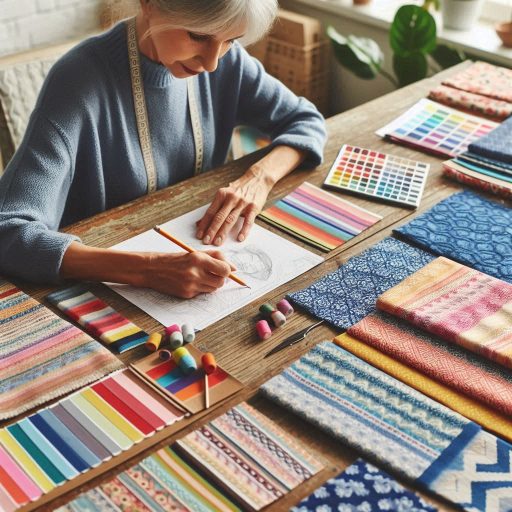Introduction
The textile industry is a major global force, producing clothing, fabrics, and other materials essential to modern life.
It plays a vital role in economies worldwide, providing jobs and driving fashion, manufacturing, and innovation.
However, this industry is also one of the largest contributors to environmental degradation, responsible for significant water pollution, excessive waste, and high carbon emissions.
As consumer demand grows, so does the pressure on natural resources, making the industry’s environmental impact a growing concern.
Creating sustainable designs in the textile industry has become a critical priority to address these environmental challenges.
Sustainable designs focus on reducing waste, using eco-friendly materials, and promoting ethical production processes.
By incorporating sustainability into design, companies can minimize their environmental footprint while meeting consumer demand for more responsible products.
The shift toward sustainability not only benefits the planet but also aligns with the growing market preference for environmentally conscious brands and products.
The benefits of sustainable designs in the textile industry are vast.
They help reduce the use of harmful chemicals, conserve water and energy, and decrease the amount of textile waste that ends up in landfills.
Furthermore, sustainable practices can extend the life cycle of products, encouraging reuse and recycling.
However, the transition to sustainable designs comes with challenges.
Implementing eco-friendly processes often requires investment in new technologies, supply chain adjustments, and overcoming higher production costs.
Understanding Sustainable Design
Definition of sustainable design in the textile industry
Sustainable design in the textile industry refers to creating products that minimize environmental impact throughout their lifecycle.
It involves selecting eco-friendly materials, implementing responsible production processes, and considering the end-of-life of garments.
The goal is to create textiles that do not deplete resources or harm ecosystems while meeting the needs of consumers.
Sustainable design promotes a balance between economic viability, social equity, and environmental protection, ensuring that fashion can be both beautiful and responsible.
Principles of sustainable design: reduce, reuse, recycle
The principles of sustainable design can be summarized as the “three R’s”: reduce, reuse, and recycle.
Reduce emphasizes minimizing resource consumption and waste during production.
This can be achieved by using less material, optimizing manufacturing processes, and reducing energy consumption.
Reuse encourages finding new uses for textiles instead of discarding them.
This can include upcycling old garments into new products or donating clothes to extend their lifecycle.
Recycle focuses on processing old textiles into new materials, which reduces the need for virgin resources and diverts waste from landfills.
Together, these principles guide the industry toward more sustainable practices.
Importance of sustainable design for the environment and future generations
Sustainable design is vital for protecting the environment and ensuring a healthy planet for future generations.
The textile industry is one of the largest polluters, contributing significantly to water pollution, waste, and carbon emissions.
By adopting sustainable design practices, the industry can reduce its ecological footprint and mitigate climate change.
Moreover, sustainable design fosters social responsibility by promoting fair labor practices and community development.
Emphasizing sustainability in textile design ensures that future generations inherit a healthier planet, where resources are available and ecosystems thrive.
Ultimately, sustainable design is not just a trend; it is a necessary evolution for the textile industry and society as a whole.
Materials and Processes for Sustainable Designs
Choosing eco-friendly materials such as organic cotton, bamboo, and hemp
Choosing eco-friendly materials is crucial for promoting sustainability in the textile industry.
Organic cotton, bamboo, and hemp are excellent alternatives to traditional fabrics.
Organic cotton is grown without harmful pesticides, requiring less water and promoting healthier soil.
Bamboo, a rapidly renewable resource, grows quickly with minimal water and no need for pesticides.
Hemp, known for its durability, also requires fewer inputs and regenerates soil.
These materials help reduce the environmental impact of textile production while offering consumers sustainable options for clothing and home goods.
Employing sustainable production processes like water conservation, dyeing techniques, and energy-efficient methods
Beyond material selection, sustainable production processes are vital for reducing the textile industry’s environmental footprint.
Water conservation is key, as traditional textile manufacturing consumes vast amounts of water.
New methods, such as closed-loop systems, recycle water during production, significantly cutting waste.
Dyeing techniques are also evolving to minimize chemical and water usage.
Natural dyes and low-water dyeing processes offer eco-friendly alternatives to conventional dyeing, which is often harmful to the environment.
Additionally, energy-efficient methods, including the use of renewable energy sources like solar power, reduce the industry’s carbon emissions.
These innovations contribute to a more sustainable production cycle.
Impact of materials and processes on the sustainability of textile designs
The choice of materials and processes directly impacts the sustainability of textile designs.
Using eco-friendly fabrics like organic cotton, bamboo, and hemp reduces resource consumption and minimizes environmental harm.
These materials also influence consumer choices, as more people seek out sustainable fashion.
Sustainable production processes further enhance the eco-friendliness of textile designs.
Water-saving technologies, non-toxic dyes, and energy-efficient methods ensure that every step of production is more environmentally conscious.
Ultimately, integrating sustainable materials and processes into textile design not only benefits the planet but also aligns with the growing demand for ethical, eco-friendly products.
Read: Breaking Down Iconic Movie Costumes
Innovation in Sustainable Textile Designs
Introduction of new technologies such as 3D printing, digital printing, and smart textiles
Innovative technologies are transforming the textile industry, making sustainable designs more achievable.
3D printing, for example, reduces fabric waste by creating garments directly from digital patterns, using only the material needed.
This precision minimizes excess and eliminates fabric scraps, a common issue in traditional manufacturing.
Digital printing is another game-changer, using less water and ink compared to conventional printing methods.
It allows for high-quality designs with reduced environmental impact.
Smart textiles, embedded with sensors and responsive materials, add a new layer of innovation by offering garments that adapt to environmental conditions, extending product life and reducing the need for frequent replacements.
Collaboration with scientists and researchers to develop sustainable solutions
Collaboration between designers, scientists, and researchers is essential in driving sustainable innovation.
Textile companies are increasingly partnering with research institutions to explore new eco-friendly materials and processes.
These partnerships lead to breakthroughs in biodegradable fabrics, waterless dyeing techniques, and the development of plant-based textiles that reduce reliance on synthetic fibers.
For example, algae-based fabrics and lab-grown leather are emerging as sustainable alternatives to traditional materials.
By working together, scientists and designers can create solutions that not only meet sustainability goals but also enhance functionality and style in the textile industry.
Examples of successful innovative sustainable textile designs in the industry
Numerous companies have already embraced innovative sustainable textile designs.
Adidas, for instance, has introduced 3D-printed shoes made from recycled ocean plastic, highlighting how technology can turn waste into wearable fashion.
Another example is Stella McCartney, a brand known for its commitment to sustainability, which has incorporated lab-grown leather into its collections.
Additionally, the fashion label Pangaia uses bio-based dyes and sustainable materials like seaweed fibers to create eco-friendly clothing.
These examples illustrate how innovation, technology, and sustainability can work together to reshape the textile industry for a greener future.
Read: Freelance vs. In-House Costume Design Jobs
Consumer Education and Awareness
Importance of educating consumers about sustainable textile designs
Educating consumers about sustainable textile designs is essential for fostering informed purchasing decisions.
Many shoppers remain unaware of the environmental impact of their clothing choices.
By understanding sustainable practices, consumers can support brands that prioritize eco-friendly materials and ethical production methods.
Education helps create a demand for sustainable fashion, encouraging more brands to adopt these practices.
Furthermore, when consumers know the benefits of sustainable textiles, they are more likely to invest in quality products that last longer, ultimately reducing waste.
Marketing strategies to promote sustainability in the textile industry
Effective marketing strategies are crucial for promoting sustainability in the textile industry.
Brands can focus on transparency, sharing their production processes and sourcing materials.
Storytelling is another powerful tool; brands can highlight the journey of their products, from raw materials to finished garments.
Collaborations with eco-conscious influencers or organizations can also enhance visibility and credibility.
Offering incentives, such as discounts for recycling old garments or loyalty programs for sustainable purchases, encourages consumers to engage.
By using these strategies, brands can effectively communicate their commitment to sustainability and attract eco-conscious consumers.
Role of social media and influencers in spreading awareness about sustainable fashion
Social media and influencers play a significant role in spreading awareness about sustainable fashion.
Platforms like Instagram and TikTok allow brands to showcase their sustainable practices visually, reaching a wide audience.
Influencers, particularly those passionate about sustainability, can authentically promote eco-friendly brands to their followers.
They often share tips on sustainable living, inspiring their audience to make responsible choices.
Engaging content, such as behind-the-scenes production stories or educational posts about sustainable materials, can drive conversations and raise awareness.
As consumers increasingly turn to social media for fashion inspiration, these platforms are vital for promoting sustainable designs and encouraging responsible consumer behavior.
Read: Networking Events for Costume Designers

Collaboration and Partnerships for Sustainability
Working with suppliers, manufacturers, and other stakeholders to create sustainable designs
Collaboration with suppliers, manufacturers, and other stakeholders is crucial for creating sustainable designs in the textile industry.
By working closely with suppliers, brands can source eco-friendly materials that minimize environmental impact.
Manufacturers play a key role in implementing sustainable production practices, such as reducing waste and conserving water.
Engaging with stakeholders throughout the supply chain ensures that sustainability goals are met at every stage.
This collaborative approach fosters innovation, allowing companies to share best practices and develop new solutions that promote sustainability in textile design.
Establishing partnerships with non-profit organizations and environmental groups
Establishing partnerships with non-profit organizations and environmental groups enhances the sustainability efforts of textile brands.
These organizations often have valuable expertise in sustainability practices and can provide guidance on reducing environmental impact.
Collaborating with them allows brands to participate in initiatives like sustainable sourcing, waste reduction, and community engagement.
Additionally, such partnerships can help brands gain credibility and visibility in the sustainable market.
By aligning with non-profits focused on environmental causes, companies can demonstrate their commitment to sustainability and inspire positive change within the industry.
Benefits of collaboration in promoting sustainability in the textile industry
The benefits of collaboration in promoting sustainability in the textile industry are numerous.
Collaborative efforts lead to shared knowledge and resources, enabling companies to innovate more effectively.
By pooling expertise, brands can develop sustainable technologies and practices that might be challenging to achieve individually.
Collaboration also enhances supply chain transparency, making it easier to identify and address sustainability issues.
Moreover, working together fosters a sense of community within the industry, encouraging more companies to adopt sustainable practices.
Ultimately, collaboration not only promotes sustainability but also strengthens the overall resilience of the textile industry, paving the way for a more sustainable future.
Read: Building a Portfolio for Costume Design
Transform Your Career Today
Unlock a personalized career strategy that drives real results. Get tailored advice and a roadmap designed just for you.
Start NowChallenges and Solutions in Implementing Sustainable Designs
Cost implications of sustainable materials and processes
One of the primary challenges in implementing sustainable designs is the cost of eco-friendly materials and processes.
Sustainable materials often come with a higher price tag due to their production methods and sourcing.
Additionally, transitioning to sustainable production practices can require significant upfront investment in new technologies and training.
This cost barrier can deter companies, especially smaller businesses, from pursuing sustainable initiatives.
However, understanding the long-term savings associated with reduced waste, energy consumption, and consumer demand for sustainable products can help justify these initial costs.
Overcoming resistance to change in traditional practices
Resistance to change is another significant hurdle in adopting sustainable designs.
Many businesses rely on traditional practices that may be less environmentally friendly, making it difficult to shift mindsets.
Employees and management may be hesitant to embrace new technologies or processes due to fear of disruption or uncertainty.
To combat this resistance, companies must prioritize education and training.
Demonstrating the benefits of sustainable practices—such as improved efficiency, enhanced brand reputation, and increased consumer loyalty—can motivate teams to embrace change.
Open communication about the transition process also fosters a culture of collaboration and support.
Strategies for overcoming challenges and implementing sustainable designs effectively
Several strategies can help overcome challenges in implementing sustainable designs effectively.
First, businesses can start small by integrating sustainable practices into specific projects or product lines, gradually expanding their efforts over time.
Collaborating with industry partners can also provide valuable insights and resources, reducing the burden of change.
Investing in research and development can lead to innovative solutions that lower costs associated with sustainable materials.
Additionally, engaging consumers through marketing initiatives can create demand for sustainable products, making the investment more worthwhile.
Ultimately, a proactive and flexible approach, coupled with strong leadership support, will enable companies to navigate challenges and successfully implement sustainable designs.
Conclusion
Sustainable designs in the textile industry are crucial for reducing the industry’s environmental footprint.
By embracing eco-friendly materials and production processes, designers and businesses can significantly lower waste and pollution.
The shift toward sustainability in textiles is not just a trend but a necessity for the future of the industry and the planet.
Designers have the power to create lasting change by using renewable resources, reducing toxic dyes, and opting for low-impact manufacturing techniques.
Businesses must prioritize sustainability at every level, from sourcing to final production.
Incorporating ethical practices not only benefits the environment but also appeals to a growing consumer base that values eco-conscious products.
The call to action is clear: the textile industry must lead the way in sustainable design, setting an example for other sectors.
Looking ahead, sustainable designs will continue shaping the textile industry, driving innovation and ensuring a more responsible and greener future.
The impact on the environment will be transformative, creating a healthier planet for future generations.
[E-Books for Sale]
The Big Book of 500 High-Paying Jobs in America: Unlock Your Earning Potential
$19.99 • 500 High-Paying Jobs • 330 pages
Explore 500 high-paying jobs in America and learn how to boost your career, earn more, and achieve success!
See All 500 High-Paying Jobs of this E-Book
1001 Professions Without a Degree: High-Paying American Jobs You Can Start Now
$19.99 • 1001 Professions Without a Degree • 174 pages
Discover 1001 high-paying jobs without a degree! Unlock career tips, skills, and success strategies for just $19.99!




